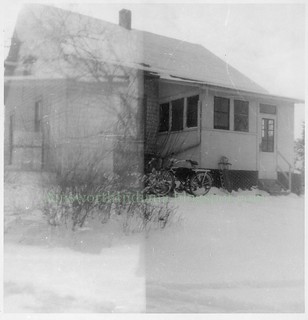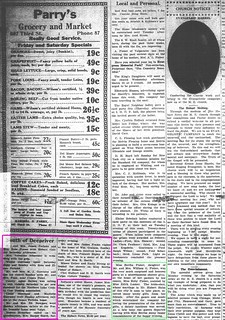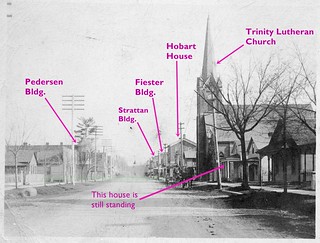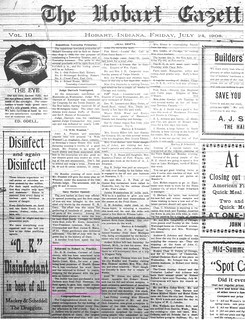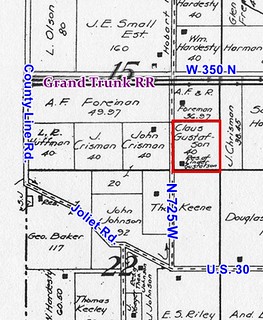1898, and 2017:

 (Click on images to enlarge)
(Click on images to enlarge)
Top image courtesy of the Hobart Historical Society.
Since the location of
this Gordon house is not general knowledge (I certainly didn't know it until very recently), I should set out my reasons for concluding that it stood on the east side of Center Street, slightly south of the Fourth Street intersection.
To establish that the house was on Center Street, here's a little item from the "Local Drifts" column of the
Hobart Gazette of July 4, 1902: "Mr. and Mrs. Howard Gordon came out from Chicago last Saturday to live in Hobart and have begun housekeeping in his father's house on Center street." We can refer to the
1880 Census or P.P. Gordon's 1904 obituary (below) to confirm the relationship between Howard and Pliny.
Fortunately for posterity, the
Hobart Gazette's 1898 Souvenir Edition reproduced a photograph of the house and identified it, and also fortunately, as we can see in the photo above, it was a fairly distinctive house — brick, two full stories, with a bay window in front (and on your left as you stand in the street facing the house), a small front porch next to it, and a small bay window towards the rear on the right side. So let's look at the Sanborn map of 1895 to see if we find a house like that.

Almost a match: it's colored red, so it's brick; most of it is two full stories; the bay window in front would be on your left as you faced the house. But what about the side bay window and the small front porch? Let's go to the 1902 Sanborn map:

Now we have the front porch and the side bay window. We know they were sometime after 1895, so they could have been there for the 1898 photograph.
Speaking of which, if we look carefully at the background of that 1898 photo, we can see that at some distance behind the house is a large structure, over two stories, with a gable topped by a chimney on the side facing the house. I think that's the Hobart Township School on Fourth Street; compare this
1894 photo and this
circa-1900 photo.
That's my case for the location of the P.P. Gordon house.
♦ ♦ ♦
Porter and Lake Counties (Goodspeed/Blanchard) included a biographical sketch of P.P. Gordon:
PLINY P. GORDON, M. D., senior member of the firm of P. P. Gordon & Bro., druggists and grocers, was born December 21, 1835, in Pennsylvania, and is one of eight children born to Edwin and Lucy (Power) Gordon, the former of New York, and the latter of Vermont. Grandfather Gordon was in the war of 1812. Two uncles were noted physicians of Detroit and Harrisburgh. When Pliny P. was four years old, his parents came to Michigan; here he lived at home until about 1860, attending school at the Ontario (Ind.) Seminary; he then began the study of medicine under Dr. Warren Byrns, of Bronson, Mich., and studied also at Ann Arbor and Buffalo, and graduated at Buffalo in the spring of 1865; he then came to Hobart and located; the first year he had a $1,200 practice, and has since run as high as $3,500; three years later, he began the drug business in partnership with his brother, and has been in that ever since; the firm has also been engaged in buying land, and at present the brothers have two farms; they have a fifth interest in the Deep River Ice Company. The Doctor is the oldest practitioner in Hobart, and has a leading practice in this part of the county. He is a Knight Templar, member of the F. & A. M. fraternity, and has been a member of the I. O. O. F. lodge; he was County Coroner for two years; he has always been a Democrat, and is a public-spirited citizen. He was married, in December, 1869, to Hettie Rifenburg, a native of New York. They have one child, Howard B. Mrs. Gordon was a teacher for a number of years.
Hettie Rifenburg was the sister of William H. Rifenburg. Much of this sketch was repeated in the doctor's obituary, printed in the
Hobart Gazette of March 18, 1904:

I believe that Mary McAfee was the widow of Samuel (
1880 Census) and her maiden name was Russell (
Indiana Marriage Collection). Dr. Gordon only flitted through the last year-and-a-half of her life.
The 1979 article that was the basis of my
Downtown Hobart 1979 blog included a story involving the Gordon brothers, set in the 100 block of Main Street:
Lot #1 of Hobart's plat was the site of Lew Hammond's tavern, a stage coach stop. In 1886 it was run by Mrs. David Young as Young's Hotel. John Gordon came from Pennsylvania that year to visit his brother, Dr. Pliny Gordon. He walked from the Pennsylvania Railroad station down Front Street and inquired at the hotel where he could locate his brother. He was told he was upstairs at a dance. John Gordon bought a ticket for $2.50 and was handed a slip of paper. This, he was told, was a deed to a lot in the new cemetery on Front Street and the dance was being given to raise money to build a fence around the cemetery to keep the pigs and cows from grazing there. Mr. Gordon relates the hotel later burned down.
I do not know the identity of the Mr. Gordon relating this story. It appears he misremembered the year, since John Gordon was already well settled in Hobart by 1882, when Goodspeed and Blanchard printed the biographical sketch above.
From a family tree on Ancestry.com comes this 1903 picture of Pliny Gordon and his first grandchild, Virginia (born in November 1902):
 Image credit: "KatharineMRedmond," Ancestry.com.
Image credit: "KatharineMRedmond," Ancestry.com.
If the photo is correctly dated to 1903, that's likely a christening gown Virginia is wearing as she sleeps in Grandpa's arms, before or after the ceremony. The overexposure of the photo makes it very difficult to judge the baby's age. If the photo dates to January 1904, then her christening gown has become her burial gown.
Little Virginia died January 17, 1904, just a couple of months before her grandfather. They are both buried in Hobart Cemetery.

